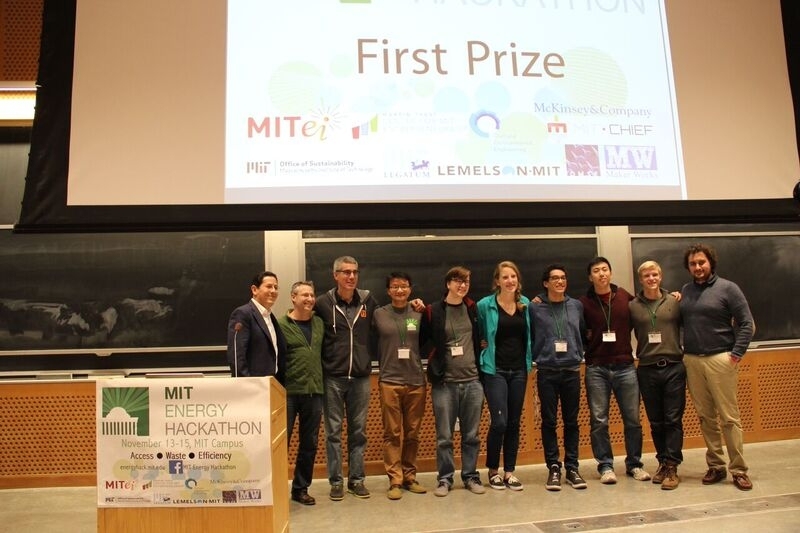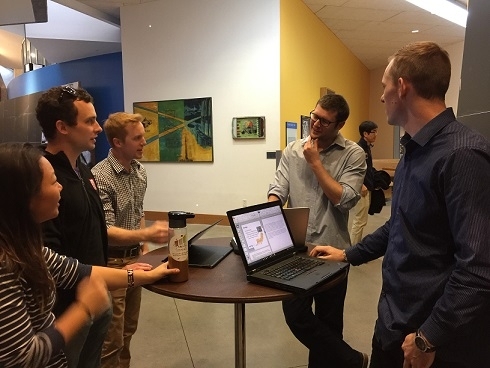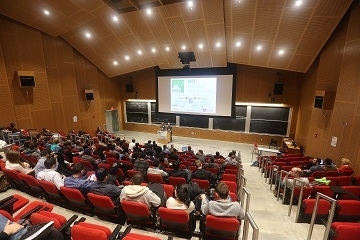While government leaders tackle long-term climate and energy issues on a global scale, the MIT community and others recently joined together for a weekend to solve current industry energy challenges. About 250 people participated in the first MIT Energy Hackathon held Nov. 13-15 on campus. The event attracted MIT engineering, programming, and business students as well as alumni and neighboring school's undergraduates and graduates.
The inaugural MIT Energy Hackathon was an offshoot of the MIT Clean Earth Hackathon held last spring, which was organized and co-led by Department of Civil and Environmental Engineering (CEE) doctoral students Jessica Bryant and Hanny Rivera. This year, Bryant and fellow CEE doctoral student Thomas Petersen stepped in as content co-directors, while and the event itself was co-directed and hosted by MIT materials science PhD student Kai Xiang and mechanical engineering undergraduate Stephen Rodan.
Nine companies and organizations — Equota, First Fuel, GreenChar, Loci Controls and Casella (in a joint challenge), McKinsey and Co., the MIT Office of Sustainability, Opower, and Solstice — provided the eight challenges, which ranged from devising new mathematical algorithms for improved energy data analyses, to optimizing oil drilling, and exploring new business models and messaging to attract new solar energy customers. Ultimately, 18 teams competed over the weekend.
“It’s great to see such an impressive response to current energy-related issues,” Bryant said. “Participants were attracted to the challenges not only for the monetary reward, but also out of a real desire to contribute to solving the energy problems facing our world. Participants also reaped the benefits inherent to hackathons, including networking and brainstorming with people with a diversity of backgrounds and expertise from across MIT and the greater Boston community.”
Judges consisted of professionals from participating companies as well as MIT faculty and staff. Winning teams were chosen based on the quality of their solution and implementation feasibility.
“It has been very formative to watch how the participants have applied orthogonal thinking and independent acquisition of new knowledge to hack the different challenges,” said one of the judges, CEE Assistant Professor Benedetto Marelli. “And all of this has been achieved in a limited amount of time. It has also been very impressive seeing participants that have never met before working together as a team during the hackathon.”
“McKinsey’s energy challenge speaks to the pressing questions surrounding unconventional hydrocarbon resources in the United States,” said CEE professor and Pierce Laboratory Director Ruben Juanes. “Its clients want to know why certain oil wells perform better or worse than other wells, and what causes the tremendous variability and uncertain pace of production decline in shale gas plays. These are billion-dollar questions, requiring research at the nano- and geolic scales. Several CEE research groups are addressing these fundamental questions, and I believe that CEE students can contribute to, and benefit from, their participation in hackathons like this, so they can experience first-hand the potential impact of their studies.”
The winning hackathon teams included Four Undergrads (first place), Buildingram (second place) and The Splitters (third place).
Four Undergrads — an apt name for MIT undergraduate students Maximilian Tang (mechanical engineering and brain and cognitive sciences), Ki-Jana Carter (nuclear engineering), Mackenzie Donnelly (chemical engineering), and Nolan Concannon (chemical engineering) — took first place, including the $3,000 prize. The team responded to Loci Controls and waste recycler Casella’s joint challenge of helping landfills optimize gas use released from their sites, a $1.5 billion opportunity according to Loci Controls’ CEO Shaun Bamforth MBA ’13.
The team presented a complete system that utilizes proven technology in the chemical processing industry to convert landfill gas into high-grade hydrogen for use in fuel cells. Novel applications of waste heat recovery and carbon capture systems ensure that the system is as efficient and environmentally friendly as possible. The system can produce significantly more income compared to traditional gas combustion methods, so even though the upfront cost would be greater, the breakeven time is the same, and profitability may be higher over time.
The second-place $2,000 award went to Buildingram for responding to First Fuel’s challenge to uncover metadata for buildings to help classify and profile them in an automated and consistent manner. For example, smart meters and sensors show ways buildings use energy over time, but more information about the age of the building and other key factors helps strengthen energy analysis and leads to better management insights.
First Fuel provided the hackers with 400 commercial addresses from across the country and asked them to show where and how waste and inefficiencies could be combatted. Buildingram investigated fundamental building characteristics of each address, such as primary business activity, number of people using the facility, and the rate and frequency of building use. It acquired much of the information and photos by deploying Web search and data finessing using Google Maps and Foursquare APIs, Facebook, Instagram, plus other social media and websites. The team was able to decipher energy use by noting construction materials, the number of floors, lighting types, shape of structures, whether solar panels were present, and other similar parameters.
The Buildingram team consisted of MIT graduate students Hang Chen and Summer Zhao; MIT alumnus Dheera Venkatraman; Yale University graduate Joy Sun; and Elaine Yuan, a young professional.
The Splitters won the $1,000 third-place prize for answering Equota’s challenge to develop a disaggregation algorithm to break down total electricity load of a building into major energy use categories such as heating, cooling, lighting, and equipment operation. Its challenge, like First Fuel’s, also focused on the need for enhanced software and data analytics to help solve energy waste and inefficiencies.
Equota provided a year’s worth of real-time utility usage for a New York shopping mall and a commercial building as the data sets. After clustering the dataset into four energy use classes — weekday vs. holiday, and open vs. closed for business — The Splitters studied the correlation of the energy consumption with the external temperature and lighting conditions, taking advantage of the weather data of the same year in the area. With the Splitters mathematical tool, lump sum “big data” was analyzed to better highlight areas for improvement or system retrofitting.
The Splitters team included Bianca Giovanardi and Simone Mazzola, visiting fellows at MIT and doctoral students from the Politecnico di Milano in Italy; plus Kehang Han, an MIT doctoral student.
The hackathon was sponsored by the MIT Department of Civil and Environmental Engineering; the MIT Energy Initiative; the Martin Trust Center for MIT Entrepreneurship; McKinsey and Company; the MIT Department of Mechanical Engineering; the MIT China Innovation and Entrepreneurship Forum; the MIT Legatum Center; the Lemelson-MIT Program; the MIT Office of Sustainability; the MIT Department of Materials Science; and MakerWorks.
The event concluded with a brief overview of the MIT Clean Energy Prize, a multi-stage business plan competition that will award over $400,000 in prizes. Designed to inspire and prepare the next generation of clean-energy entrepreneurs to tackle the world’s most critical energy challenges, it is the largest student-run clean-energy business plan competition in the world. Teams are encouraged to gather now for 2016, with applications due in February and the actual competition to take place in the spring.








